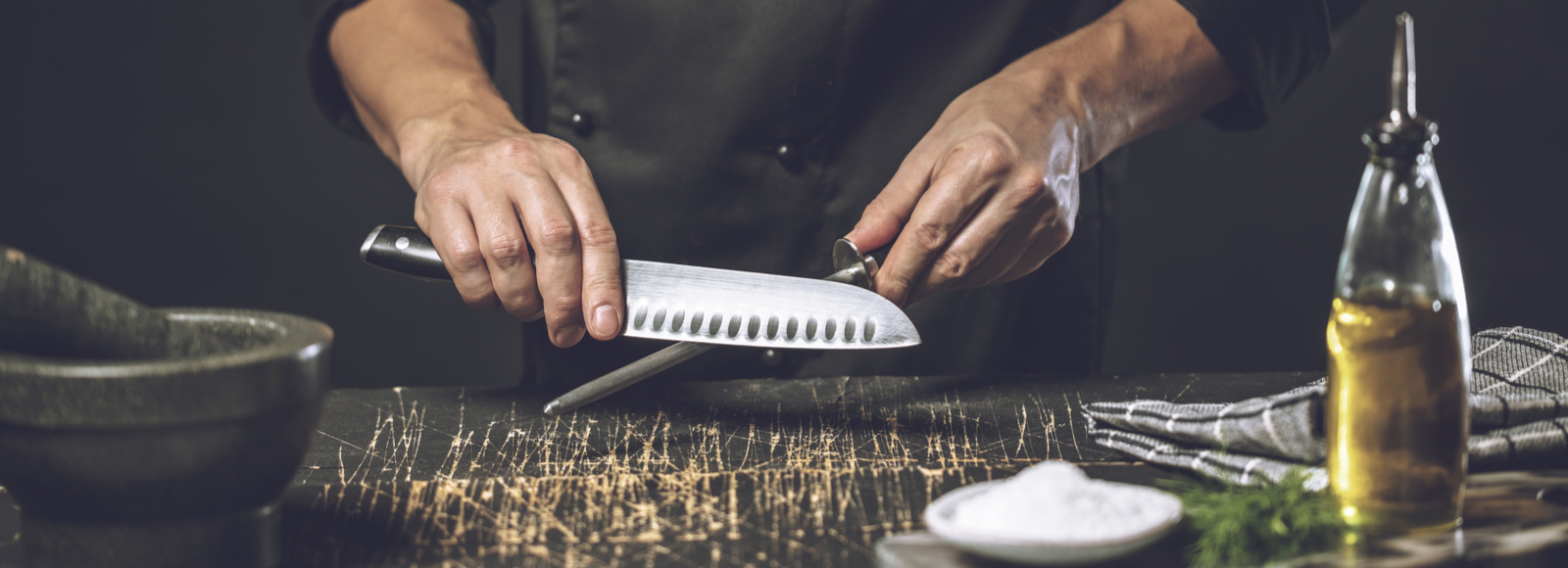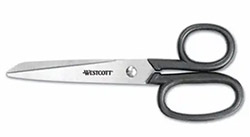The Kitchen Knives Buying Guide
 One look through the knife bag of any professional chef can leave your head reeling. With so many different types and styles of these vital kitchen tools to choose from, how do you know which ones you really need to bring your favorite recipes to life?
One look through the knife bag of any professional chef can leave your head reeling. With so many different types and styles of these vital kitchen tools to choose from, how do you know which ones you really need to bring your favorite recipes to life?
As it turns out, there is no one clear answer to this question. Why not? Because just as each cook’s needs are different, so too their knife needs will be different, and will depend entirely on their own unique habits and preferences. To help you get started on cultivating a knife collection of your own, we’ve put together this handy resource on all things knives. Happy shopping!
The Most Important Tool in Your Kitchen
If you think that amassing a diverse collection of knives is merely a luxury, think again. Choosing the right knife will help you achieve optimal results in the kitchen.
Whether you’re looking to save time, achieve a particular texture, or prevent injuries and promote kitchen safety, selecting the correct knife is an important part of food prep. Using the wrong knife can damage the food product as well as the user. Most professional chefs would agree that quality knives are the most important kitchen tools.
Buying a knife is only part of the process. Learning how to use each knife in your collection is equally important. Most professional chefs take years to hone their skills and become comfortable performing all kinds of kitchen tasks. As with nearly everything in life: practice makes perfect.
Knife Shopping 101: Top 10 Knives
 If there was a "Most Valuable Player" of kitchen knives, most professional chefs would easily agree that it is the chef’s knife. Also called a "cook’s knife," this incredibly versatile, all-purpose knife has a wide blade and relatively long length, making it a go-to for chefs looking to maximize productivity without sacrificing quality. Chef’s knife blades come in a variety of sizes, starting with 6 inches and spanning all the way to 14 inches, however 8 inches is the standard length.
If there was a "Most Valuable Player" of kitchen knives, most professional chefs would easily agree that it is the chef’s knife. Also called a "cook’s knife," this incredibly versatile, all-purpose knife has a wide blade and relatively long length, making it a go-to for chefs looking to maximize productivity without sacrificing quality. Chef’s knife blades come in a variety of sizes, starting with 6 inches and spanning all the way to 14 inches, however 8 inches is the standard length.
So what can you do with a chef’s knife? The more appropriate question might be, what can’t you do? Originally designed to slice and disjoint large cuts of beef, the chef’s knife is handy for a wide range of tasks, from the most delicate to the toughest. Perfect for slicing, dicing, mincing, trimming, chopping and carving, it can easily manage all of these tasks and more. An important thing to keep in mind is that chef’s knives are the workhorse in the kitchen, so they will require proper and frequent sharpening for best performance.
If you’re just beginning to build your knife collection, or if you have a small budget, the chef’s knife is the best way to spend your savings.
 Designed for cutting fruits and vegetables, or cutting poultry, a utility knife allows for more precise cutting than a chef's knife. With a size somewhere between a paring knife and a chef's knife, at anywhere from 5 to 7 inches, and a thinner blade, a utility knife is the perfect size for maneuvering through narrow food cavities.
Designed for cutting fruits and vegetables, or cutting poultry, a utility knife allows for more precise cutting than a chef's knife. With a size somewhere between a paring knife and a chef's knife, at anywhere from 5 to 7 inches, and a thinner blade, a utility knife is the perfect size for maneuvering through narrow food cavities.
Utility knives are available with either plain or serrated edges. A serrated utility knife is your best bet for cutting everything, from crusty bread to a perfectly ripe peach. In fact, thanks to its surprisingly delicate touch, the serrated utility knife is a stand-out among kitchen knives for its capacity to cleanly slice through tough outer edges without destroying a food’s more fragile insides.
 Available in a wide range of blade sizes from 7 to 10 inches, with either straight or curved edges, bread knives are perfect when slicing -- not chopping -- is the task you need to perform. A gentle sawing motion allows this knife’s serrated edge to grip and cut through crusty bread without mangling the softer innards.
Available in a wide range of blade sizes from 7 to 10 inches, with either straight or curved edges, bread knives are perfect when slicing -- not chopping -- is the task you need to perform. A gentle sawing motion allows this knife’s serrated edge to grip and cut through crusty bread without mangling the softer innards.
![]() For many chef's. a paring knife is the go-to knife when a chef's knife is too large. Thanks to its lightweight, compact size and unbeatable maneuverability, chefs turn to paring knives for everything from peeling fruit to filleting fish Paring knives feature short, yet powerful blades that make them ideal for cutting hard-to-reach places or for tackling tasks where precision is key. Paring knives are categorized by their different blades such as the curved blade, bird's beak and serrated blade, each serving it's own purpose in the kitchen.
For many chef's. a paring knife is the go-to knife when a chef's knife is too large. Thanks to its lightweight, compact size and unbeatable maneuverability, chefs turn to paring knives for everything from peeling fruit to filleting fish Paring knives feature short, yet powerful blades that make them ideal for cutting hard-to-reach places or for tackling tasks where precision is key. Paring knives are categorized by their different blades such as the curved blade, bird's beak and serrated blade, each serving it's own purpose in the kitchen.
Need to core apples, trim mushrooms, or peel garlic? Then this 2-4 inch short knife is the perfect choice.
 Fillet knives are known for their high degree of precision. Featuring a long narrow length and a flexible blade, the average length of a fillet knife is usually 5 to 9 inches long. Thanks to the upward curve along it's blade, and a sharp curved tip, this knife moves easily along the backbone and under the skin of fish, making it perfect for deboning salmon or cutting thin fish slices. It can also be used to remove bones and skin from meat.
Fillet knives are known for their high degree of precision. Featuring a long narrow length and a flexible blade, the average length of a fillet knife is usually 5 to 9 inches long. Thanks to the upward curve along it's blade, and a sharp curved tip, this knife moves easily along the backbone and under the skin of fish, making it perfect for deboning salmon or cutting thin fish slices. It can also be used to remove bones and skin from meat.
![]() A must-have for meat lovers, slicing knives are suited for much more than cutting thin cuts of turkey, chicken, pork, beef, and steak. These knives, with a long blade and a rounded or pointed tip, are also ideal for slicing up uniform pieces of sushi and sashimi. The average blade length is from 9 to 13 inches and they feature granton, serrated or straight edges.
A must-have for meat lovers, slicing knives are suited for much more than cutting thin cuts of turkey, chicken, pork, beef, and steak. These knives, with a long blade and a rounded or pointed tip, are also ideal for slicing up uniform pieces of sushi and sashimi. The average blade length is from 9 to 13 inches and they feature granton, serrated or straight edges.
7. The Cleaver
 Not for the faint of heart or hand, cleavers -- easily identifiable by their heavy, rectangular blades -- are well-suited for heavy-duty kitchen tasks, including cleaving (natch), hacking, chopping, and mincing. But if you think that cleavers are exclusively for tough jobs, you underestimate their full potential. The truth is that they're incredibly versatile when being used by professionals, so much so that Chinese chefs use them just as much as Western chefs use chef’s knives.
Not for the faint of heart or hand, cleavers -- easily identifiable by their heavy, rectangular blades -- are well-suited for heavy-duty kitchen tasks, including cleaving (natch), hacking, chopping, and mincing. But if you think that cleavers are exclusively for tough jobs, you underestimate their full potential. The truth is that they're incredibly versatile when being used by professionals, so much so that Chinese chefs use them just as much as Western chefs use chef’s knives.
 The boning knife is a powerful tool that can easily debone chicken, meat and fish. The thin, sharp blade ranges from 5 to 8 inches in length, and is perfectly suited for separating proteins from the bone, as well as for carving and trimming. Depending on your needs and preferences, boning knives are available with blades ranging from flexible to stiff and everything in between.
The boning knife is a powerful tool that can easily debone chicken, meat and fish. The thin, sharp blade ranges from 5 to 8 inches in length, and is perfectly suited for separating proteins from the bone, as well as for carving and trimming. Depending on your needs and preferences, boning knives are available with blades ranging from flexible to stiff and everything in between.
 The name of this Japanese-designed knife translates to “three virtues", but its possibilities far exceeds slicing, dicing, and mincing. Known for their multi-purpose functionality and sharp edges, Santoku knives offer a nimble alternative to heavier chef’s knives. They are also unique in appearance thanks to their granton edge release patterned blade and narrow, cleaver-like shape.
The name of this Japanese-designed knife translates to “three virtues", but its possibilities far exceeds slicing, dicing, and mincing. Known for their multi-purpose functionality and sharp edges, Santoku knives offer a nimble alternative to heavier chef’s knives. They are also unique in appearance thanks to their granton edge release patterned blade and narrow, cleaver-like shape.
10. Kitchen Shears
 While technically not a knife, kitchen shears can be used in place of knife for many common kitchen cutting tasks. Need to cut up scallions and herbs? Try cutting them up quickly with kitchen shears. Featuring thick and strong blades, shears can handle many types of foods including sectioning chicken, preparing shrimp, and even slicing pizza!
While technically not a knife, kitchen shears can be used in place of knife for many common kitchen cutting tasks. Need to cut up scallions and herbs? Try cutting them up quickly with kitchen shears. Featuring thick and strong blades, shears can handle many types of foods including sectioning chicken, preparing shrimp, and even slicing pizza!
Beyond the Top 10
Beyond these commonly used knives, lies a wide range of other types of knives that you may need to use for specific purposes. A butcher may need gutting knives, frozen food saws and skinning knives, whereas a fish cutter may require filet knives, and oyster and clam knives. A baker will need decorating knives and cake knives while a deli clerk may need sandwich spreaders, butter knives abd cheese knives. Knowing which specific, repetitive tasks you need to perform in your commercial kitchen will help you choose the proper kitchen knives and increase your speed and efficiency.
Forged vs. Stamped Knives
An important point to understand when building your knife collection, are the two different methods used in making knives: forged and stamped.
Forged knives are pounded into their specific shape through the application of intense pressure, refined through grinding and honing, and then riveted or laminated to the handle. A forged knife is identifiable by a bolster that helps balance the blade by adding weight near the center of the knife. Many chefs like the feel of a bolster, which gives them a safe place to rest their fingers while they are using the knife. The forging process also makes the steel stronger, so not only will it keep an edge for longer, it will also be easier to sharpen. It's strength however, makes it less flexible than stamped knives, which may be a disadvantage, depending on how you use your knives. The biggest disadvantage of forged knives however, is their price. They are far more expensive than their stamped counterparts, but will last a life time.
Stamped knives are "stamped" from a flat sheet of metal using a hydraulic press before being ground and honed into their final shape. The handles are then either glued on or crafted around the knife. Since they don't go through the same forging process that makes forged knives so strong, they are more flexible and keep an edge for a shorter time. An advantage of stamped knives however, is that they are flexible, which makes them useful as boning and filleting knives. In addition, they are much less expensive than forged knives, so if you are looking to build a knife collection, you will be able to acquire more stamped knives for the money.
Putting cost aside, the choice between forged and stamped knives should ultimately be guided by how they feel in your hand and how comfortable they are to work with. Many manufacturers produce both types of knives with a large selection, with lots of different pricing options, so you can easily mix and match your knife collection to meet your specific needs.
Blade Types
There are numerous blade types to choose from, the most common being: stainless steel, high carbon stainless steel, carbon steel and ceramic.
- Knives with stainless steel blades are very affordable and resistant to rust and corrosion, however they don't resharpen as well, or hold a good edge, for as long as other types of blades.
- High carbon stainless steel blades offer a very good balance of sharpness, edge retention, easy resharpening, and are rust and corrosion resistant, making them a popular choice among professional chefs.
- Carbon steel blades hold their edge for longer and are easier to sharpen than steel. Many professional chefs swear by the extra sharpness of carbon steel knives, however they require much more maintenance than other knives which may be a drawback for some.
- Knives with a ceramic blade are super-hard, lightweight, ultra-sharp and will hold an edge for longer than the other knives mentioned. The main drawback of a ceramic knife is that it can shatter if dropped or break if handled improperly.
Maintaining Your Knife Collection
Knives are an investment, and should be treated as such. Here are a few tips for keeping your knives in good working order:
Sharpening Knives
A knife is only as effective as its condition, so to keep them safe to work with and at their best, they need to be sharpened and honed regularly. There are various types of sharpening tools you can use to sharpen and hone your knife collection. Sharpening stones help to straighten and refine the cutting edge on the blade by sliding the knife across the top. Knife sharpeners are a simpler way to sharpen dull edges on knives, by pressing the blade in the slot and pulling it in and out, your blade will be sharpened. Once your knives are sharpened, it is recommended to hone your knife with a honing or sharpening steel. These realign the knife's edge to help keep the knife sharp.
Storing Knives
There are several ways to store your knives to both preserve them and keep them safely out of the way.
- Knife blocks,
- Wood or lined storage trays,
- Magnetic knife holders, (particularly useful when space is tight),
- A knife bag, good for on-the-go chefs.
Cleaning Your Knives
Most experts recommend hand-washing your knives after each use by using hot water and soap and hand drying afterwards. For knives that are dishwasher-safe, usually less expensive stainless steel knives, they can be placed on the top rack of your dishwasher in utensil racks so they don't bump against other things in the machine.
High-quality kitchen knives can last a long time, particularly with proper maintenance. However, if you notice cracks and/or loose parts, it’s time for a replacement. Not only can broken knives trap food and make them difficult to clean, the risk of injury increases when you are working with damaged cutlery.
A Final Word on Knives
Wondering whether to buy single knives or spring for a whole set? This is largely a matter of personal preference. In some cases, it makes sense to buy only the knives you need to execute your style of cooking at your current cooking level. In other cases, a well-stocked knife collection may give you more versatility and opportunities for practice.
Knives are not a one-size-fits-all proposition. Are you dicing, slicing, mincing and chopping with the proper tool for the job? If not, you may be getting less-than-perfect results despite your best efforts. Adding a new knife to your collection; upgrading old, worn, or broken knives; or investing in a completely new set of knives can have transformative potential when it comes to both ease of preparation and the quality of your work product.